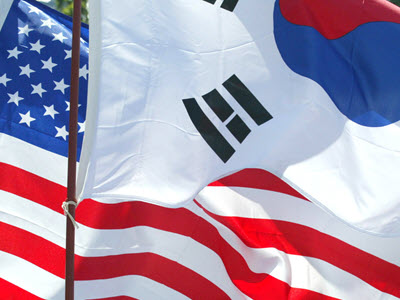Extended Deterrence in the U.S.-ROK Alliance
Adapting to a New Threat Environment
Jennifer Lind argues that the extended deterrence challenge resulting from the game-changing development of North Korea’s intercontinental capabilities could very well lead to a serious crisis in—or even the termination of—the U.S.-ROK alliance. This commentary is part of the roundtable “Updating the U.S.-ROK Alliance for New Frontiers.”
South Koreans are increasingly debating a previously unthinkable topic: nuclear weapons acquisition. The topic now appears regularly in the media, and President Yoon Suk-yeol’s comments on the issue have attracted global attention. The Biden-Yoon summit in April concluded with the Washington Declaration, which sought to reassure South Koreans of the credibility of the U.S. nuclear umbrella. While the declaration represents an important step, NATO’s extended deterrence crisis in the 1960s suggests that South Korean concerns will persist. Given this outlook, South Korean and U.S. leaders should continue to study and debate measures to reassure Seoul and bolster deterrence on the Korean Peninsula.
Responding to Changes in the Nuclear Balance
North Korea’s advances in its nuclear program—particularly its development of intercontinental ballistic missiles—have transformed the nuclear balance. War on the Korean Peninsula would create serious escalation risks. Previously, the United States promised to retaliate against a North Korean nuclear strike on the Republic of Korea (ROK), knowing that Pyongyang could not strike the United States. Now, however, North Korea’s intercontinental reach would enable it to retaliate against U.S. cities, reducing the likelihood of U.S. retaliation on South Korea’s behalf. This weakens the deterrent threat vis-à-vis North Korea and reduces U.S. credibility in the eyes of South Koreans. Many observers connect doubts about U.S. credibility to Donald Trump’s presidency (and to the prospect of a second Trump administration). However, any rational U.S. leader would hesitate to give an order that could lead to the deaths of millions of Americans—the greatest foreign policy catastrophe in U.S. history.
The allies tackled the issue of extended deterrence at the April summit in Washington, D.C. Yoon’s visit to the White House and address to a joint session of Congress honored the 70th anniversary of the alliance and showcased the two allies’ warm and multidimensional relations. The summit produced the Washington Declaration, which states that “any nuclear attack by the DPRK against the ROK will be met with a swift, overwhelming and decisive U.S. response.” South Korea expressed “full confidence in U.S. extended deterrence commitments” and reaffirmed its Nuclear Non-Proliferation Treaty obligations. The Washington Declaration included a pledge by the United States to “consult with the ROK on any possible nuclear weapons employment on the Korean Peninsula,” to engage in joint wargaming, and to create a Nuclear Consultative Group to discuss nuclear and strategic planning. After the summit, the United States also announced port visits by U.S. nuclear submarines to South Korea.
Reactions in South Korea were polarized. Liberal critics lambasted Yoon for following Washington into a new Cold War with China, while conservatives decried him for accepting “nuclear shackles” and worried that the nuclear crisis persists. Some argued that “the unpredictability of U.S. politics” meant that the declaration could become “a meaningless piece of paper.”
Although the Washington Declaration astutely addressed the challenges facing the alliance, NATO’s experience suggests that additional measures—including policies currently rejected by the Biden administration—may be necessary. In the 1960s, the Soviet Union’s successful development of intercontinental nuclear capabilities touched off a crisis in NATO about the credibility of U.S. promises to retaliate against a Soviet nuclear strike in Europe. U.S. leaders attempted unsuccessfully to mollify allied fears with gestures akin to those in the Washington Declaration. But another important lesson is that different countries accepted different solutions.
The United States stationed U.S. nuclear weapons in Europe and created the program of NATO nuclear sharing with Belgium, Italy, the Netherlands, and West Germany. France, however, was not satisfied with those policies so acquired an independent arsenal. These measures create a set of possible options for South Korea and the United States today.
Key Issues for Legislators
The U.S. Congress should recognize that one of the United States’ most important alliances has entered a challenging period in which the U.S. nuclear umbrella is in doubt. Members of Congress should understand that the extended deterrence challenge could very well lead to a serious crisis in—or even the termination of—the U.S.-ROK alliance. Thus, congressional leaders should monitor the administration’s handling of alliance policies and, informed by the NATO case, debate how best to reassure Seoul as well as bolster deterrence. Congressional committees should hold hearings about deterrence on the peninsula that feature diverse views and different kinds of expertise (e.g., diplomatic, technical, and regional). The current problem does not relate to spending; that is, it will not be solved by raising defense spending or purchasing a particular weapons system. But Congress should nonetheless evaluate whether planned U.S. defense arrangements and spending in Asia appropriately address the evolving North Korean threat.
For its part, the ROK National Assembly should also study the evolving North Korean threat and work with the Blue House and its expert community to evaluate whether existing policies adequately address the threat at hand. The National Assembly should oversee continued development of South Korea’s conventional capabilities to increase deterrence and might consider investing in infrastructure or conventional capabilities (akin to the existing ballistic missile submarine program) that would serve as a nuclear hedge.
The National Assembly should also support efforts to connect South Korea to a regional security architecture. As Brad Roberts argues, “many of the multi-domain solutions to the challenges of deterrence and assurance on the Korean peninsula will not be found on the peninsula alone.” In particular, members should appreciate the advantages of cooperation with Japan on intelligence sharing and missile defense. A supportive role with the National Assembly is essential for such cooperation to endure.
On both sides, U.S. and ROK leaders should remember that the current crisis stems not from either country’s failings, nor from a lack of warmth in the alliance—which, as the Biden-Yoon summit showed, is profound. Rather, the crisis stems from the game-changing development of North Korea’s intercontinental capabilities. With 70 years of security cooperation, South Korea and the United States are well positioned to successfully adapt the alliance to the changing threat environment.
Jennifer Lind is an Associate Professor of Government at Dartmouth College, a Faculty Associate at the Reischauer Institute of Japanese Studies at Harvard University, and an Associate Fellow at Chatham House.



